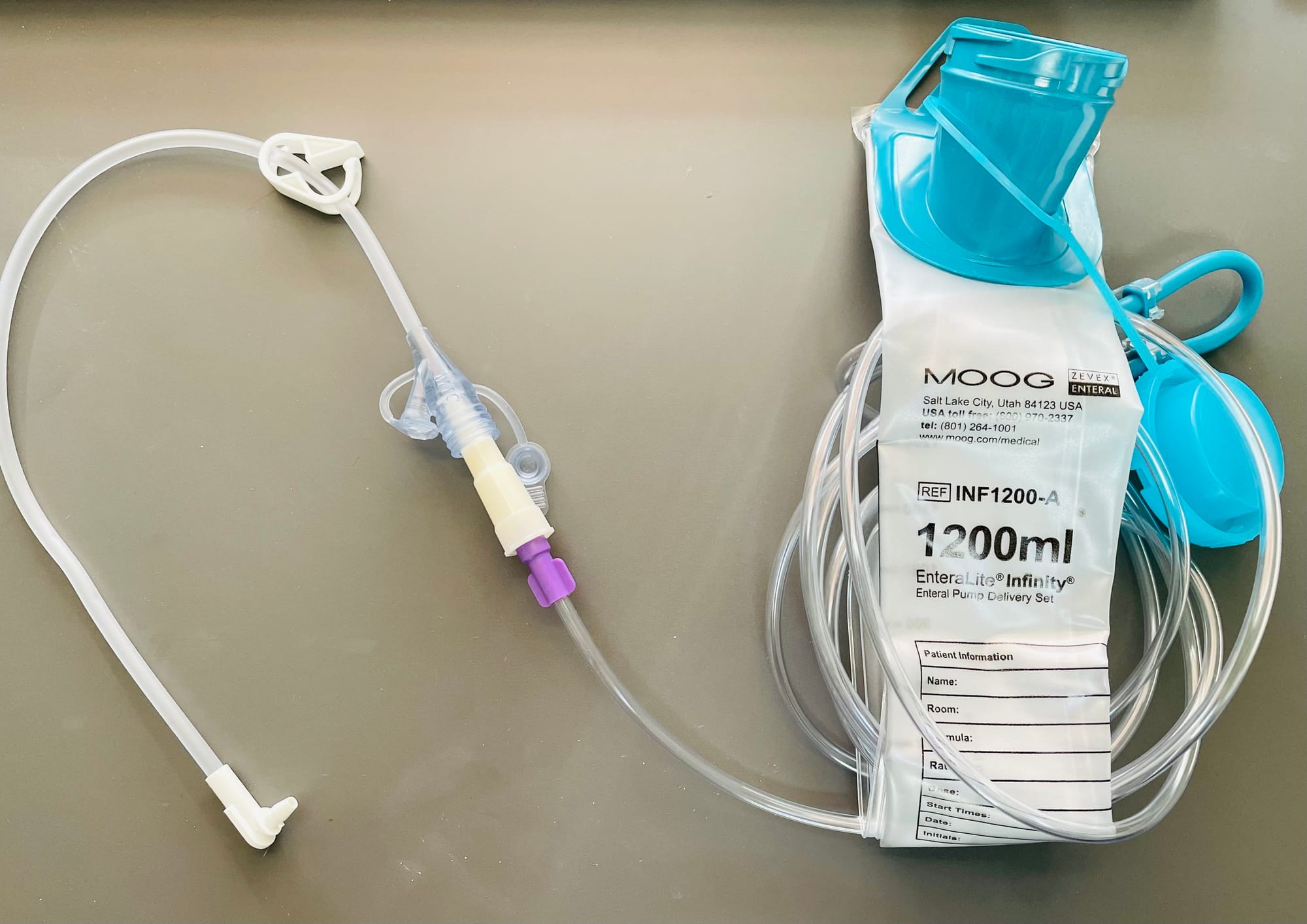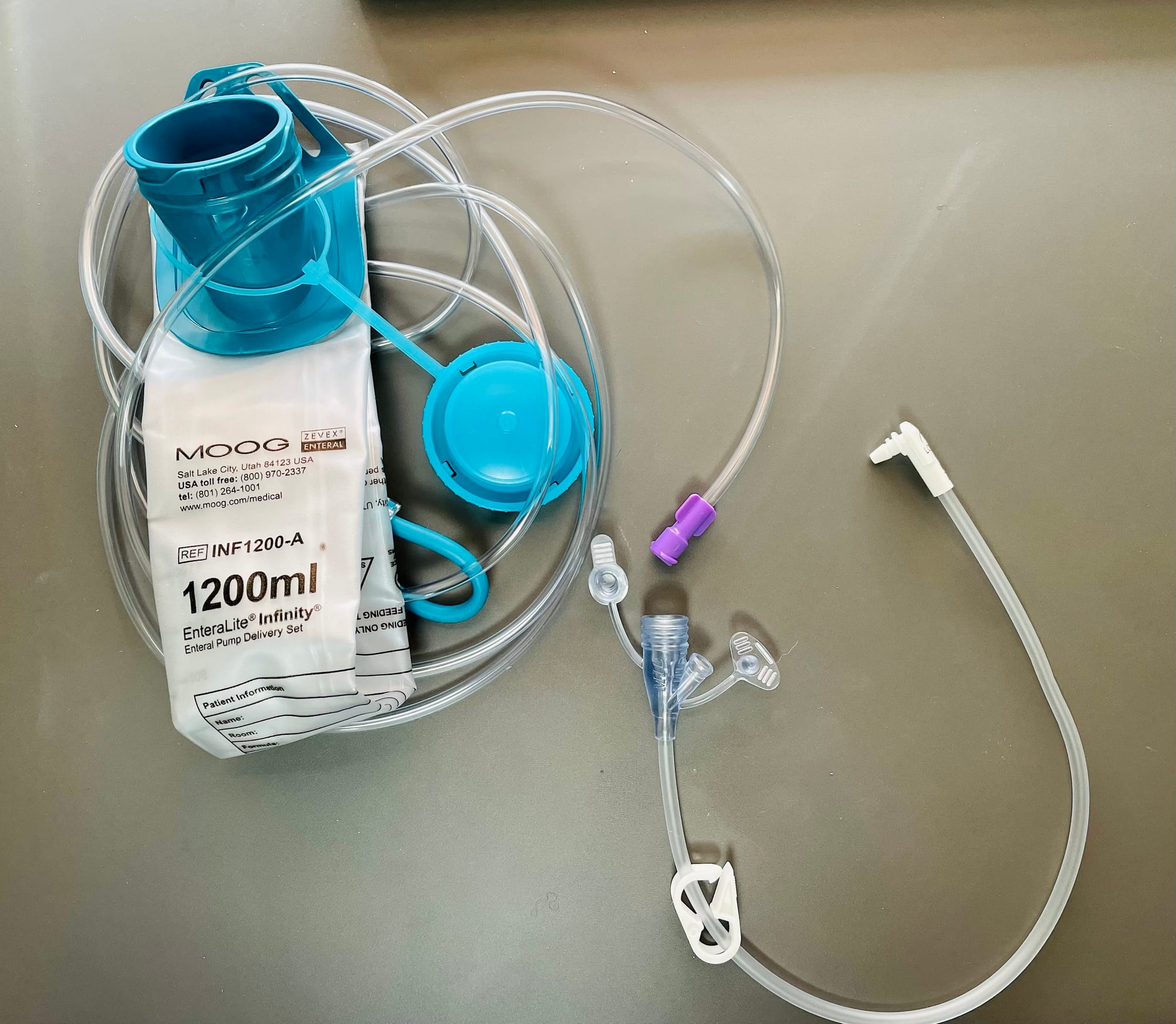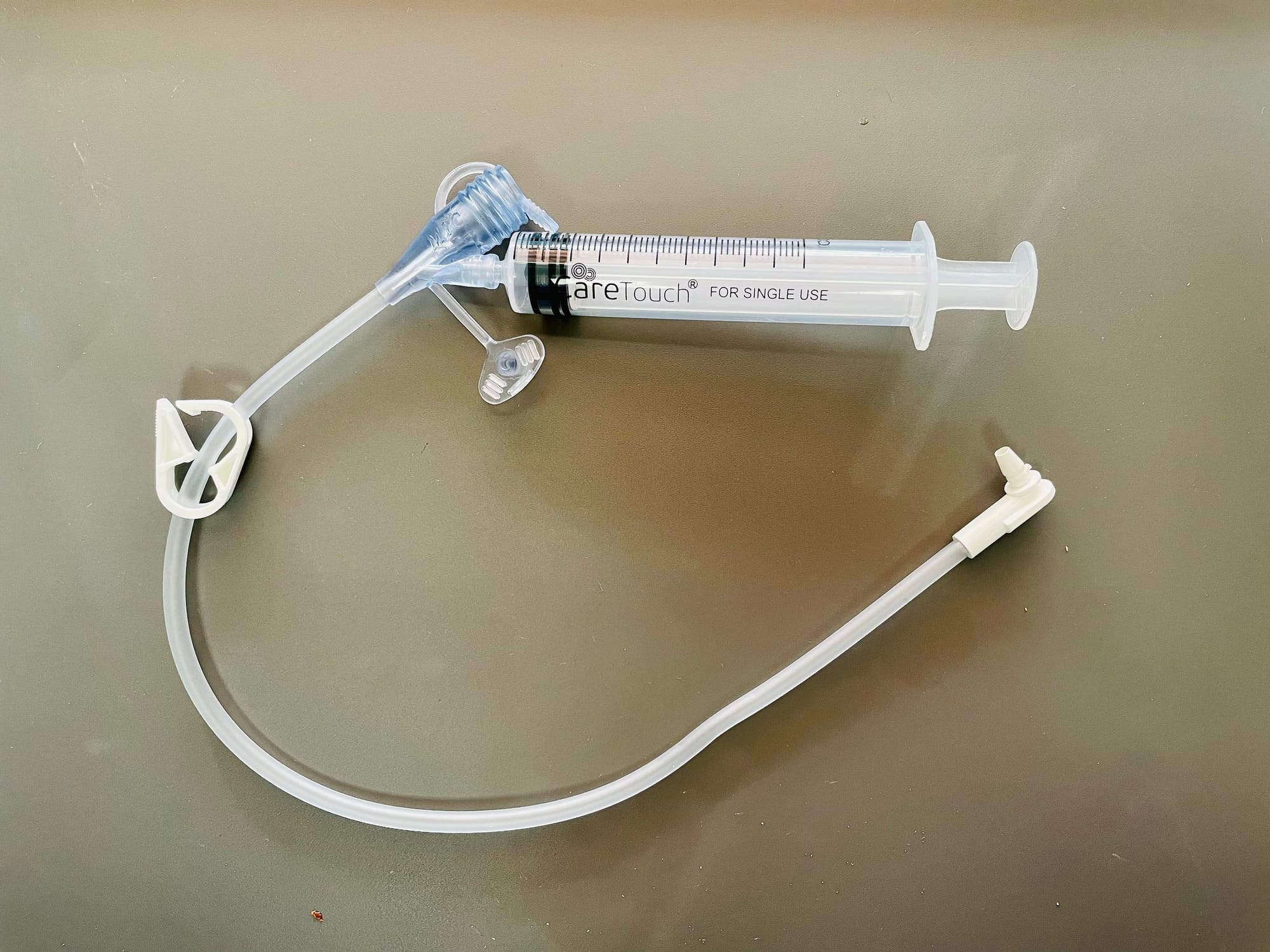When No One Consults the Disability Community: The Unfit Transition to ENFit (by Sandra Joy Stein)

This is the feeding system G- and J-tube users have relied on for decades. Note how the white nozzle fits snugly into the extension set. [image description: A MOOG feeding bag (with aqua and purple features) is connected to an extension set.]
“Hey there”, my email to our enteral supplier began in as friendly a tone as I could muster, “We received my son’s tube-feeding supplies and after his home health aide went to hang one of the bags, she realized that the wrong feeding bags were sent. We usually get INF0500-A (with nozzle). This time we received INF0500-E (without nozzle). We tried one of the INF0500-E to see if we could get it to work without the nozzle but it leaked into his bed. Can we please get the correct bags sent as soon as possible?”
The response came quickly, informing me that the manufacturer is no longer making the INF0500-A, the product we have used for over a decade when my son had surgery to place a gastrostomy tube and we learned a whole new vocabulary:

In this photo, the white nozzle is removed from the purple ENFit tip. The old-style extension set does not have a matching screw-in end. If the purple end is plugged into the extension, fluid leaks around the gaps in the threads, which do not correspond with the grips on the extension set. [image description: the same feeding system, but with the white nozzle removed.]
- A gastrostomy tube (aka, ‘g-tube’ or ‘peg’) is the plastic button inserted in the stomach through a surgical opening called a stoma. Because my son cannot swallow liquids safely, this is how he drinks water and takes medication–just like thousands of other disabled people. For several years my son took all his nutrition via this tube, just like many people who cannot swallow safely at all; this was how he ate.
- Extension sets are tubes that connect the ‘peg’ to the syringes or feeding bags used to give medication, food, and water.
- Enteral means anything that passes through the intestines. We get all the above items through an enteral supplier.
- I’d thought there was just an issue with the feeding bags, but then the supplier threw me another curve ball, saying that the new extension sets sent with our last shipment were compatible with the new bags.
What new extension sets? I wondered. I asked my son’s home health aide. She said there were some unfamiliar supplies she had put away and showed me the new purple-adorned extension sets that connect the gastrostomy tube to the new purple-adorned feeding bags. The lovely purple ends on each screw into one another. However, the medication syringes we have available do not have these purple screw connectors and once we run out of our stock of the old extension sets, I will not be able to give my son medication.
This new system is called “ENFit” and as much as my son and I like the snazzy purple, we now have lots of 60cc and 10cc syringes that are not compatible with it. I asked our supplier if I could get more of our original extension sets, but, apparently, they have been discontinued, too. “Oh,” I snapped, “Was anyone going to tell the people who actually use these supplies?”
Realizing that I might soon be unable to give my son the medications that we use over fifteen syringes for each day, I asked, “Can we get medication syringes that work with this new system?” The supplier said syringes are the responsibility of pharmacies, not enteral suppliers. I asked why the change was happening so suddenly and without notice, given the vital importance of these supplies.

The new ENFit extension set is pictured. Because the standard syringe is not designed with a screw-in end, the syringe cannot be connected. Sandra’s family cannot locate any of the ENFit-compatible syringes. [image description: A pair of hands with aqua nail polish holds a standard medical syringe, demonstrating that it cannot fit an ENFit extension set, which has a purple end.]
Minutes later I received an email from the supplier with a link to a Businesswire website wherein the Global Enteral Device Supplier Association (who knew there was such a thing?) declared their support for ENFit on behalf of patient safety, noting that the change was “supported by clinicians, regulatory agencies, patient safety organizations, Group Purchasing Organizations (GPOs), Durable Medical Equipment providers (DMEs), manufacturers and suppliers.” Now that the ENFit parts screw into each other, there is less chance for accidents, spillage, and medication errors.

This is a standard slip-tip syringe fitted snugly into the port of an old-style extension set. [image description: a 10 cc medical syringe is connected to a feeding extension set.]
Sounds great! But one group in that long list of supporters is missing: gastrostomy tube users themselves. What are disabled people and their families supposed to do during this mismanaged and incomplete transition?
I called our local pharmacy. Staff told me their suppliers do not carry the purple ENFit products and, in any event, they are on backorder. I called our specialty pharmacy who directed me to the pediatrician. The pediatrician’s office is trying to locate these syringes, but staff are telling me they are hard to find.
In the midst of this mess, the group chat for my tube-feeding support group lit up. “They switched us. Halfway. Brilliant,” one texted. “I have the new syringes if you need some,” offered another. “How did you get them?” I asked. “The supplier sent them, but I had to ask. Our supplier also did it without much notice or a real transition plan,” was the reply.
For now, my family is switching back and forth between the old parts and the new parts (literally connecting and disconnecting two different extension sets to the tube in my son’s body) as we give him medication or water, depending on which syringes or bags we do or don’t have. We’re spending down the last of our precious non-purple extension sets, using them past their typical expiration, while we figure out how to get the ENFit syringes without privately paying every month for boxes of supplies that our insurance policy covers.
This unnecessary scramble could have been avoided if the Global Enteral Device Supplier Association (Twitter handle @GEDSA_org) had involved g-tube users and their families from the beginning in the ENFit transition, instead of relying on the “expertise” of executives at manufacturers, hospitals, and facilities. People who live day-to-day with gastrostomy tubes understand ALL of the consequences of a switch in supplies, including the interdependencies of compatible tubes, pumps, bags, extension sets, and syringes. Until the disability community and caregivers are centered in these decision-making processes, we will continue to scramble, urgently and reactively, to the missteps of the industries we rely on.
Sandra Joy Stein is a writer and educator who lives in New York. Her son gave permission to tell this story, but did not want his name or photo in this piece.
